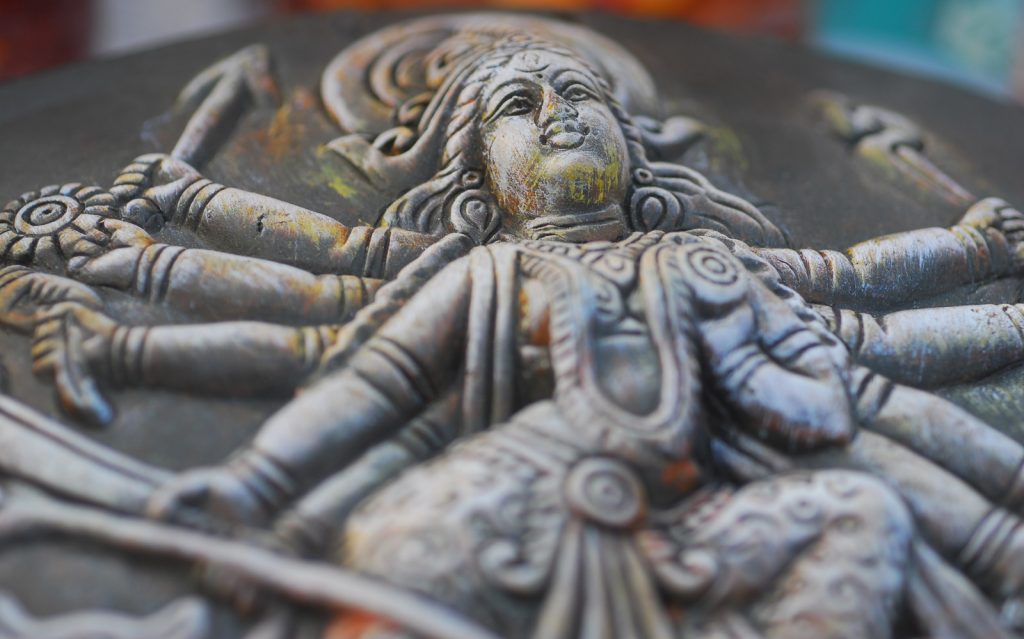There are few things that bind a community more than durga pujas bind bongs. A bong’s annual calendar is marked by the days of the durga pujas. Every year when the new almanac is brought out the first thing a bong probably does is to look up the days of durga pujas. While the new year of the Bengali calendar starts in April, in baishakh, it actually start on the last day of durga pujas and runs till the start of the next years pujas. A count down of one year for Ma Durga to come back and fill our lives with grace that only a mother can give, joy that only a daughter can. To a bong ma durga is not the fiery warrior Goddess but the mother who protects and fills our life with abundance and joy. She is the daughter come home from her husband’s place with her children, to be pampered and cared for, and cried for when she departs back for a year.
The month of ashvin in the Indian calendar is special to most Indians. This is the time of Navratri. This is the time of the victory of good over evil as embodied by the victory of Lord Rama over the demon Ravana. It is Lord ram who worshipped the Goddess Durga to gain victory over His arch enemy, and it is said that the priest for the said puja was Ravana himself. On the 10th day ravana is quelled and celebrated as dusshera across India, whether that be through the burning of the idols of ravana and his brother, or the grand elephant processions of Mysore. In Bengal however, Dashami is marked by tears, as the idols of ma durga is immersed in the holy water of Ganges, tears flow in Her wake

Durga puja celebrations begin with Mahalaya the last day of pitripaksha, with obeisance being paid to the ancestors. To Bengalis, mahalaya symbolises waking up in the wee hours of the day and following Birendra Kishore Bhadra’s baritone voice from the times of All India Radio till date. Young and old mesmerised by Ya Devi Sarvabhuteshu waking us through bleary eyes. The next few days are a rush of activities, last minute shopping, rehearsals for programs for cultural programs and decorations of the pandals. While in earlier days, pujas would start from the sixth day or shasti, commercialisation has seen the start elongated so that the sponsors can have more eyeballs through greater footfalls. Political hues have been added with various political leaders patronising their own pujas and going on inauguration sprees.
Shasthi the 6th day is the day when the bodhon or welcoming of the goddess in the idol is done, thus making the idol and embodiment of the Goddess and thus ready for worship. Saptami or the 7th day is signified by two main events, the Kala bou snan and NavaPatrika Pujan. Ganesha’s wife is worshipped in the form of a kala bou or a banana tree. A ritualistic procession to the ghats where the Kala bou is bathed and then brought back, draped in a saree and worshipped is the highlight. Nava Patrika pujan or worship of the Godess with 9 types of leaves is another highlight of this day. Banana, Pomegrenate, Turmeric, Jayanti, Ashok, Bel, Aurum, colacassiaand paddy are the 9 plants, and are together tied to form the kola bou. 108 lotus flowers are also used for the worship of the goddess on this day. It is believed that the Warrior Godess started her battle with the Bull demon Mahisasur on this day. Ashtami or the 8th day is believed to eb the most auspicious day. Rituals as astra pujan or the worship of the arms, kumari pujan and sandhi pujan are the highlights of this day. All 9 forms of durga (durga abd the ashta saktis, viz. Brahmani, Maheswari, Kaumari, Vaishnavi, Varahi, Narasinghi, Indrani and Chamunda) are worshipped on this day. It is believed that the Gods gave the Goddess on this day and thus the arms or astras are worshipped on this day. Kumari puja or the worship of the goddess embodied in a girl of pre puberty age or kumari is a tradition that has emanated from the Ramakrishna Order, propagated by Swami Vivejkananda the disciple of Sri Ramakrishna Paramhansa. The Last 24 minutes and the first 24 minutes of Navami is referred to as the sandhikhan, and a special puja is done during ths time. Navami of the ninth day is the day when Goddess Durga starts her final assault in Mahisasur. Balidan or sacrifice is done on this day. With a whole lot of people abhorring animal sacrifice today a symbolic sacrifice of pumpkin or gourd is done today. Dashami or the tenth and last day of the festival is often referred to as ViajayDashami as the Goddess finally conquers and quells the demon. The goddess is carried to the river along with her children and then immersed back first into the wager to let the clay dissolve signifying her journey back to Kailash and her heavenly abode.
To Bengalis, this is not just a festival, but a time for expression. From the pandals housing the idol, to the idols, it marks epitomisation of the creativity of Bengalis. Various themes and ideas are often established and highlighted during this time. Artists use various forms of expression whether through art, music, or dance to show case their creativity in the best possible way during this time. Bengal decks up like a new wed bride to welcome her daughter with open arms. It is a festival of getting together, feasting, music and togetherness for the days that the mother resides and then tears to wash her feet as she goes on her way. The people of Bengal waiting for the year to roll over from that day so that the day of her advent comes quick and early. To a Bengali durga puja is not just a festival but a celebration of everything that is Bengali and integral to the Bangaliana or Bengali way







